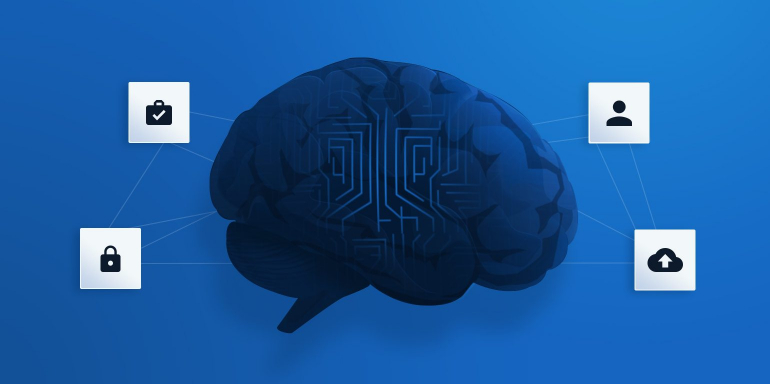Predictive intelligence might sound like a futuristic tool that belongs in a science fiction film. But today’s marketers are using the technology to deliver what their customers want before they even know they want it.
Predictive intelligence tools are helping companies like furniture retailer Room & Board improve their bottom line and reach customers more effectively. They implemented Salesforce’s Marketing Cloud technology that analyzed customer traffic data and predictive analytics to suggest additional purchases to customers in real time. The result was an incredible 2900% ROI.
Granted, not many businesses will enjoy the same success as Room & Board. But the technology has evolved so much to the point that marketers can’t ignore some new revelations — like a system that offers recommendations based on customer traffic patterns.
Providing customers with a personalized experience continues to prove a positive ROI. If you’re unfamiliar with the concept, you should know what predictive intelligence is and what tools are available.
What is predictive intelligence?
Sometimes referred to as predictive analytics, predictive intelligence is a method of creating a customer experience that is unique to one particular individual by monitoring customer behavior and building a profile of their specific preferences. This profile data is then used to predict what customers will want next.
For example, let’s say an online shopper just purchased a flat screen TV. These new intelligence tools would detect the purchase and send the shopper an email in real-time suggesting a coffee table or a TV stand. This eliminates the need for humans to manually consider each aspect of a customer’s profile and makes marketing more efficient.
How it’s changing B2B marketing
Marketers used to score leads manually to determine which stage prospects were at in the customer journey. Manual lead scoring occurs when marketers assign a grade or numerical value to certain leads based on their analysis. For instance, if a marketer notices a pattern where leads who watch a product demo convert at a higher rate, demo watchers might be given an “A” grade while leads who didn’t watch the demo might be given a “B” grade.
Conversely, predictive lead scoring uses a prospect’s behavior and past buying history to determine what they are looking for and whether they are even looking to buy. The predictive lead scoring uses big data determine which leads are most likely to convert, so salespersons can focus on the leads that will provide the company with the most value.
Lattice Engines and Mintigo are two companies that provide cloud based B2B analytics services like predictive lead scoring. Lattice Engines searches social networks, public databases, and web pages and combines that information with internal customer data to help businesses find optimal sales prospects. DocuSign used predictive lead scoring firm Lattice Engines to find the leads most likely to convert. The result was a 38% increase in the predictability of conversions.
Mintigo uses artificial intelligence to power its predictive marketing platform by continuously collecting information such as hiring trends, marketing channels used, and technologies installed. Next, they use this data to determine which B2B leads are the highest value. Then, it is combined with a company’s internal marketing automation platform to determine where sales teams should focus their resources.
Clearly, predictive intelligence is helping marketers become better at gaining insights into customer behavior. Here are a few of the tools marketers are using to become more efficient:
Machine learning
A 2014 Forrester Consulting study asked 121 respondents what their top three challenges were. Listed at 3 and 4, respectively, were analyzing streams of data from every customer interaction and applying those insights to improve customer experiences:

As big data continues to evolve, marketers are working with increasingly large streams of data that can be difficult for humans to manage. Machine learning is a solution to this problem. Machine learning is the process where systems sift through large sets of data to look for patterns and then adjust their program based on the new information.
Staples is using machine learning to collect information about their corporate buyers’ preferences in a few distinct ways: with self-service shoppers via their website and their Easy Button as people speak into it. Both of which help Staples better predict their shopping needs. As shoppers speak into the button over time, the bot identifies what the customer needs and improves its responses.
Artificial intelligence
One of marketers’ biggest problems is that they aren’t always provided with data that gives them a complete picture. Artificial intelligence can find new data sources on the web, such as news stories, social media updates, and databases. All of this additional data helps marketers to find higher quality leads and to personalize content for their prospects better.
Artificial intelligence is also a strong tool for personalization. AI can tailor emails specifically to your customers brand preferences by using their shopping history and consumer profile. The tool is so powerful that a Demandbase survey found that 80% of marketers believe AI will revolutionize the marketing industry within the next 5 years:
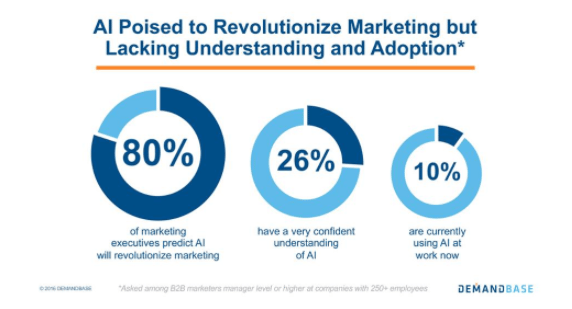
Although marketers are big believers in the power of artificial intelligence, they’re not quite sure how to implement it yet. Only 26% of marketers surveyed by Demandbase said they had a very confident understanding of AI. Imagine having a sports car in your driveway but not understanding how to operate a vehicle. That’s the stage many marketers are currently at with artificial intelligence.
If marketers want to use machine learning, artificial intelligence, and other tools effectively, then it’s essential they know what trends are on the horizon. Here are three trends that are driving change in B2B marketing.
3 Predictive intelligence trends
Research has shown that predictive intelligence produces higher employee engagement and customer lifetime value. A 2016 study from the Aberdeen Group indicated that predictive analytics could increase average profit margin per customer by nearly 5%, and customer lifetime value by 10% over non-users:
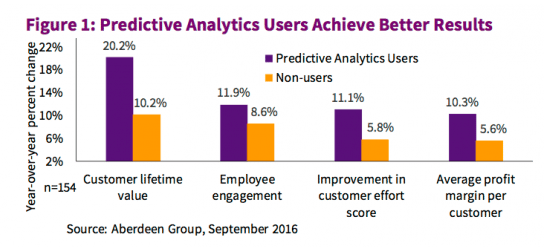
With more businesses investing in predictive intelligence, it is important to know what to expect over the next several years.
The rise of chatbots
Chatbots are increasingly using machine learning to become smarter and provide better answers to customers over time. Customers can get answers to their questions about a product or service without having to scour an FAQ page or make a time-consuming phone call.
Chatbots have become an important tool for businesses looking to automate more processes and provide the best user experience as possible. In the first 6 months of 2016 alone, $58 million was invested in chatbots. Plus, Gartner predicts that by 2020, customers will hardly even interact with an enterprise on a human-to-human level:
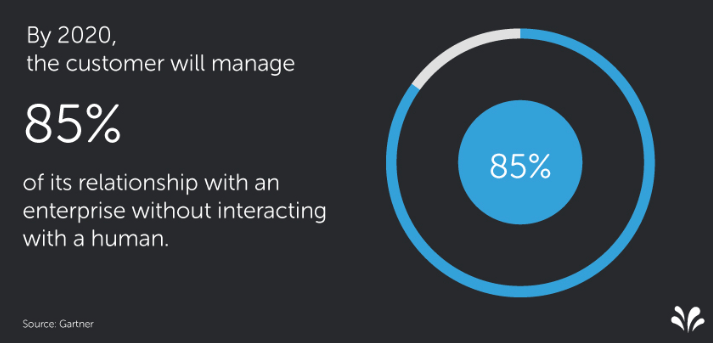
The technology will undoubtedly mature and the questions asked by customers will likely be added to their consumer profile to form a better picture of where they are in the customer journey and what services they might buy.
Intelligent apps
Machine learning won’t only be a tool that tech behemoths like Facebook can afford anymore. Intelligent apps will become mainstream sooner than you think. Soon, most companies will be using apps that rapidly analyze large amounts of data and change their program based on new information. And if you don’t believe that, believe this: In 2016, TechCrunch learned that 90% of startups they met with planned to use machine learning to improve their customer experience.
There will also be a growing marketplace for algorithms that power intelligent apps. Algorithmia is one such marketplace. Mashape is another marketplace for APIs that developers use to build intelligent apps. Marketers will increasingly rely on algorithms to run intelligent apps that provide personalized solutions to their customers.
Marketplaces are important because they reduce friction in the buying and selling process. With a simpler buying process, that means faster adoption of intelligent apps and the APIs that power them.
Big data sees an increase in investment
A survey from DNV GL – Business Assurance found that 76% of all organizations are looking to increase or maintain their investment in big data between now and 2019. The survey also found that a majority of enterprises globally see big data as an opportunity. Companies that invest more in big data are seeing improvement in efficiency and decision making, and businesses are also embracing big data as a way to capture and store critical information about their customers:
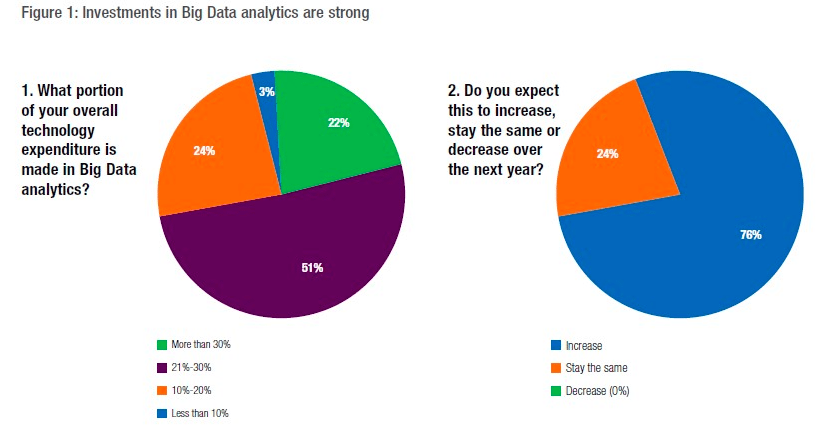
With a new focus on machine learning and artificial intelligence, the data that powers these processes have to come from somewhere. Big data gives these tools the information they need to paint a more complete picture for marketers. Without large amounts of data, predictive intelligence can lead to the wrong conclusions and point marketers in the wrong direction. That’s why big data must be cultivated alongside predictive tools.
Predictive customer intelligence examples
Businesses are trending toward greater use of predictive analytics. But it isn’t just a technique for the future. Right now, companies are using predictive tools to improve their bottom line and becoming more efficient.
InsideView
InsideView is a marketing and sales company that needed a more effective way to determine which leads were worth pursuing. At the time, InsideView only had two sales reps and determining which inbound leads were highest priority was a lengthy 18-day process, a number the company wanted to reduce dramatically.
They then turned to SalesPredict’s predictive analytics solution for intelligent insights on lead scoring. The solution used thousands of signals to produce insights about a lead’s buying intent. Predictive analytics allowed InsideView to create a score for each lead that was incorporated into the company’s existing marketing automation.
The result? InsideView’s lead qualification process was now reduced to 2 days. Furthermore, their conversion rate increased by 25% and the company experienced 100% growth in its qualified sales pipeline.
U.S. Cellular
U.S. Cellular wanted to learn which website optimizations they could implement to drive revenue and how effective each of those actions were. They hired Cardinal Path to complete a purchase intent analysis (a form of predictive analytics) to discover which website actions were most predictive of future purchases.
There was a belief that prospects who used the add to cart or store locator feature on the company’s website were higher value leads. Cardinal Path found that prospects who used U.S. Cellular’s “Chat Now” or “Offers” feature were more likely to make a future purchase than prospects who used a store locator. U.S. Cellular used these insights to focus on more qualified leads which resulted in a 61% increase in customer lifetime value.
Which technology will you take advantage of?
Predictive business intelligence technology such as machine learning and AI are no longer foreign concepts you can ignore. They’re here to stay and changing digital marketing as we know it. Both allow marketers to create personalized solutions for customers and staying on top of related trends can help your business become more efficient in the future.
Start personalizing your customer’s post-click landing page experience, sign up for an Instapage Enterprise demo today.

See the Instapage Enterprise Plan in Action.
Demo includes AdMap™, Personalization, AMP,
Global Blocks, heatmaps & more.
